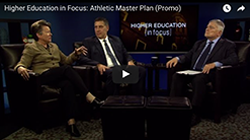We live in interesting and challenging times. I learn a great deal about “our times” when presidents and chancellors gather to discuss what is happening on their campuses. I just returned from such a meeting of the AAU (American Association of Universities). The AAU membership is comprised of the 62 most accomplished universities in the U.S. and Canada. A major topic of discussion was the protests and office occupations at many, many universities. The discussions prompted by these protests have considerable breadth. Students across the country are describing situations of implicit bias in and out of the classroom that are based on stereotypes. There is a strong reaction against hate speech and explicit bias that has created a considerable level of discomfort and a real sense of vulnerability felt by different student populations. We also are seeing, on campus after campus, a collision between free speech and our values of inclusion, and our desire to provide a welcoming and successful environment for all students regardless of heritage, beliefs or appearance. In many ways, college campuses are becoming “ground zero” for this debate, even as we also watch all of these issues unfold on the national stage.
The comments by leaders of AAU institutions have a close parallel with what students and faculty are telling me at Penn State. Interestingly, the comments also are the same regardless of student group.
Implicit bias
We might begin with the particularly challenging issue of implicit bias. To what extent do stereotypes drive our expectations at this university? There is a science to this – consider Claude Steele’s book Whistling Vivaldi, in which the author describes a graduate student at the University of Chicago who whistled Four Seasons to counter a negative stereotype associated with his race — that, as a black man, he was a potential danger walking down the street. Steele’s book is full of carefully crafted studies that involve gender, race, sexual orientation and even age.
Many of us recognize “how stereotypes affect us and what we can do” (the subtitle of his book). But the fact that so many of our students, here and at other universities, are talking about this topic should give us pause — and the examples are sometimes surprising. Consider the comment from a Penn State Asian student seeking help in math, and hearing a faculty member say the equivalent of “I thought Asian students were good at math.” This stereotype was reinforced last night when Molly and I attended Asian Spotlight and a W.O.R.D.S performer intoned “Asian privilege, calculator in my head, no one knows how hard I worked.” I remember clearly a faculty member in the Department of Geography, Lorraine Dowler, who studied gender roles in society, revealing that when she saw a firefighter in New York remove their gear, she caught herself being surprised because the individual was female — she had made an assumption about identity even though she is an accomplished scholar in that very field of study. Lorraine provided one of many powerful examples that has forced me to examine my own actions and thoughts. We all have biases, but I believe we must ask ourselves at what point do they have a negative impact on student success.
Explicit hate
Our Penn State experience with explicit hateful and racist social media posts is no doubt still fresh in our minds. So, let me give you a different example, one where hate and fear combine with a growing stereotype. A few years back, I was doing a review of a university in Saudi Arabia. One of the Saudi faculty members arranged a traditional dinner on the coast near the city of Dammam. We were early and he took a detour around the town, and then said, “Look, there is a radical.” I turned, curious to see what an extremist would look like, but I was unable to distinguish the individual from any other Saudi citizen. The faculty member then described a list of “visual cues” that he thought distinguished the individual. He then said something that I thought was profound. He said, “You Americans think that man hates you, but in fact he just hates, and he is as likely to hate me for my beliefs (even though we are both Muslim) as he is to hate you.” And, in response to his and others’ hate, we have a world with greater fear and a heightened sense of vulnerability. Then we begin to frame our views by taking the hate that comes from some and attaching it to a people or to a religion or a country or perhaps even a university.
The reality is, wherever you go, in any race, or religion, or country, or university, you can find people who just hate.
Finding civility and speaking out
What can we do? Do we institute mandatory training on implicit bias? Do we seek to silence individuals with ugly social media posts? Interestingly, national student surveys suggest that more students than ever are willing to give up aspects of free speech in order to create a more civil environment.
I have strong views on this topic. We have to stand up for discussing difficult issues, and we must always stand up for free speech — it is a fundamental right of our constitution and ensures that our ideas find their way into the marketplace of society.
As Supreme Court Justice Douglas recognized, speech may provoke emotions and cause discomfort, but this may serve a useful purpose if it then causes us to strike out at injustices, prejudices and preconceptions. And while standing up for free speech, we must speak out. It is for that very reason Justice Douglas described that I have been explicit in stating that there is no place for hate at Penn State. It is unacceptable to have students, each of whom have earned their place here by their intelligence and hard work, to feel vulnerable.
My ‘struggle’
Today, I have made another rather explicit comment. I have joined a group of our students seeking to educate us about bias and stereotypes, and the degree to which words can become truly loaded. Consider the word “jihad” — I am willing to bet that nearly everyone sees this word only as defining a radical hatred associated with a religion. Yet, a key meaning of the word is “struggle.” Yesterday, our students held up signs as a way to alter a growing stereotype — signs like “my jihad is to prevent sexual violence.” I have my own jihad. My jihad is to provide a high-quality education that is affordable, where cost does not limit access to any hard-working bright student.
In stating my jihad, my struggle, I believe I am standing up for Penn State values.
Our community of faculty, staff and students have defined these Penn State values. “We respect and honor the dignity of each person, embrace civil discourse, and foster a diverse and inclusive community.” Each of us has the opportunity to live the value of Respect. It is my preference to argue for civility while simultaneously preserving the fundamental right of free speech. It is my preference that we seek the “useful purpose” that sometimes stems from emotional reaction and discomfort so that we ensure that color, or religion, or heritage, or sexual orientation do not limit access to an education at Penn State.
Sadly, we will never stamp out hate and I am equally sure that we will not stamp out bias, but I believe we must seek the moments to strike out at injustice, prejudice and preconception.







Good morning President Barron:
Hearing you share your Jihad with CORED, I thought I’d share a couple articles in this newsletter.
Report Underscores Continuing Inequality in Higher Education –
http://nasfaa.informz.net/z/cjUucD9taT01NTQ0Nzg2JnA9MSZ1PTEwMDcwMDQ4OTAmbGk9MzQ4OTIzNTE/index.html
Report: College Scorecard Earnings Data Only Influences Well-Resourced Students
http://nasfaa.informz.net/z/cjUucD9taT01NTQ0Nzg2JnA9MSZ1PTEwMDcwMDQ4OTAmbGk9MzQ4OTIzNTI/index.html
Eric,
I found your blog post interesting during my early reading this morning. All of the writings you have posted on this general subject are of personal and professional interest to me.
I’ve attached a recent column you might find interesting in case you didn’t see it. It is related and most appropriate for this discussion… along with being quite informative as it relates to happenings at Penn State over the last five years.
Opinion | The Shame Culture
The New York Times
A new moral system is coming into place. Read the full story http://www.nytimes.com/2016/03/15/opinion/the-shame-culture.html?_r=0